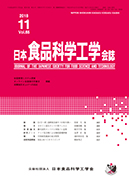
- |<
- <
- 1
- >
- >|
-
Hisashi Matsubara, Gou Kimura, Megumi Takeuchi, Tadashi Takahashi, Ken ...2018 Volume 65 Issue 11 Pages 503-507
Published: November 15, 2018
Released on J-STAGE: November 22, 2018
JOURNAL FREE ACCESSIn Northern Japan, mackerel is a popular fish, but there is no culture of consuming it as sashimi. The present study aimed to establish a handling method for frozen mackerel that would make full use of freezing technology, give root to a culture of consuming mackerel as sashimi, and improve the value of mackerel. The influence on the freshness of raw materials from being kept in frozen storage conditions over a period of time on K-value1) and rate of inosinic acid was investigated. The proper thawing method was also examined. As a result, it was revealed that eating mackerel in a sashimi state was possible after defrosting at low temperatures in running water, if highly fresh material was frozen quickly, kept at -30°Cand stored less than 10 months. It might not be easy if only established techniques are used, but we think that the flavor of the Hachinohe mackerel is appealing enough to enable a change in the culture.
View full abstractDownload PDF (1114K)
-
Miho Takahashi, Mayu Suzuki, Tsubasa Kato, Kenji Ogino, Emi Ohtake, Na ...2018 Volume 65 Issue 11 Pages 508-517
Published: November 15, 2018
Released on J-STAGE: November 22, 2018
JOURNAL FREE ACCESSThe formation of mixed protein films using heat-coagulable proteins (commercial whey or soybean protein) and a heat-stable protein (sodium caseinate) was investigated using ultrasound spectroscopy, mechanical measurement, differential scanning calorimetry, scanning electron microscopy and Fourier transform infrared spectroscopy. Sodium caseinate enhanced the initial heat-denaturation of the coexisting proteins, but inhibited the subsequent coagulation. The mixed protein films showed enhanced mechanical properties, and higher glass transition temperature and water solubility compared to the whey or soybean protein films. These results suggest that the heat-stable protein could act synergistically with heat-coagulable proteins in the mixed system, resulting in the development of a novel film.
View full abstractDownload PDF (2187K)
-
Chiaki Arai, Rieko Hirose, Mikiko Tozaki, Satoshi Yamaguchi, Minoru Su ...2018 Volume 65 Issue 11 Pages 518-528
Published: November 15, 2018
Released on J-STAGE: November 22, 2018
JOURNAL FREE ACCESSThe effect adding acid-soluble wheat protein (ASP), mainly composed of gliadin, to wheat flour and rice flour blend bread in mechanized bread-making was investigated using the following method. Rice flour was used to replace 40% of the wheat flour, and wheat protein (gluten and ASP) was added to constitute 10% of the total mixture, thus replacing 20% to 40% of the gluten with ASP. In the sponge and dough method, the addition of ASP improved the gas holding capacity of the sponge, and the dough development time shortened during the mixing process. In addition, molding conditions for mass production were improved due the suppression of changes in dough rheological properties caused by the time lag during the dividing process. Microstructural observation of sheeted dough showed that the gluten network of the dough extended in a uniform direction. Consequently, it was shown that the addition of ASP resulted in increased extensibility of the dough. As a result, the addition of ASP improved uneven crumb structure after baking and decreased the rate of crumb firmness during storage (20°C, 24-96 hours). In conclusion, the addition of ASP improved the stabilization of the bread-making process and increased the product quality of wheat flour and rice flour blend bread in mechanized bread-making.
View full abstractDownload PDF (2682K)
-
Takumi Kanazawa, Yukiharu Fukushi, Hideyuki Chiji2018 Volume 65 Issue 11 Pages 529-533
Published: November 15, 2018
Released on J-STAGE: November 22, 2018
JOURNAL FREE ACCESSThis study investigated the physiological effects of phenolic amides (N-trans-feruloyl-3-O-methyldopamine and N-trans-feruloyltyramine) derived from the seeds of sugar beet (Beta vulgaris L. var. saccharifera Alefeld). The phenolic amides inhibited triglyceride accumulation in 3T3-L1 adipocytes and pancreatic lipase activity in vitro. Specifically, N-trans-feruloyltyramine inhibited triglyceride accumulation more effectively and for a longer duration compared to N-trans-feruloyl-3-O-methyldopamine. This is the first report on the inhibitory effect of N-trans-feruloyl-3-O-methyldopamine on triglyceride accumulation. These results suggest that the phenolic amides from sugar beet seeds have inhibitory effects on pancreatic lipase activity and intracellular triglyceride accumulation.
View full abstractDownload PDF (705K)
-
Mayuka Ikeda, Naoki Narisawa, Shin Abe, Yasuyoshi Torii, Fumio Takenag ...2018 Volume 65 Issue 11 Pages 534-540
Published: November 15, 2018
Released on J-STAGE: November 22, 2018
JOURNAL FREE ACCESSWe examined the chemical composition of commercially available Chinese and Japanese fish sauce products made from raw fish and salt. The Chinese fish sauce contained higher salt and succinic acid and somewhat less titratable acidity and total nitrogen compared to the Japanese product. An important characteristic was observed in the ratio of glutamic acid to total free-amino acid contents. Some of the Chinese products showed glutamic acid contents of 20 to 45%, which are higher than the glutamic acid content of fish meat protein. Thus, these samples may have been supplemented with glutamic acid.
View full abstractDownload PDF (427K)
-
Hideyuki Kajiwara2018 Volume 65 Issue 11 Pages 541
Published: November 15, 2018
Released on J-STAGE: November 22, 2018
JOURNAL FREE ACCESSDownload PDF (254K)
- |<
- <
- 1
- >
- >|